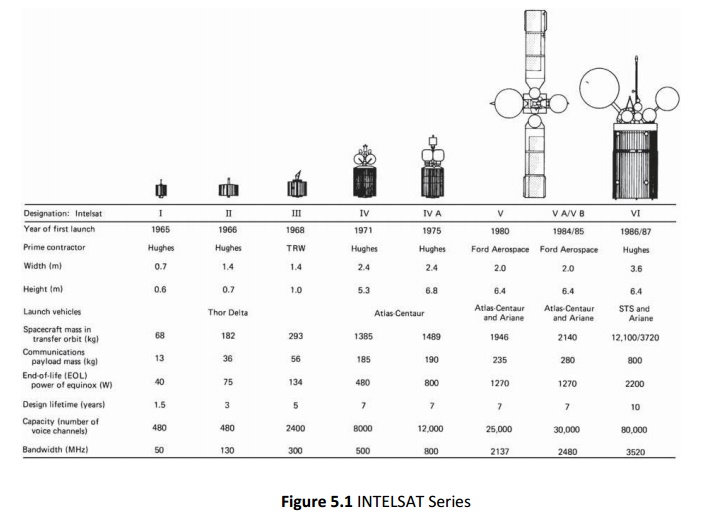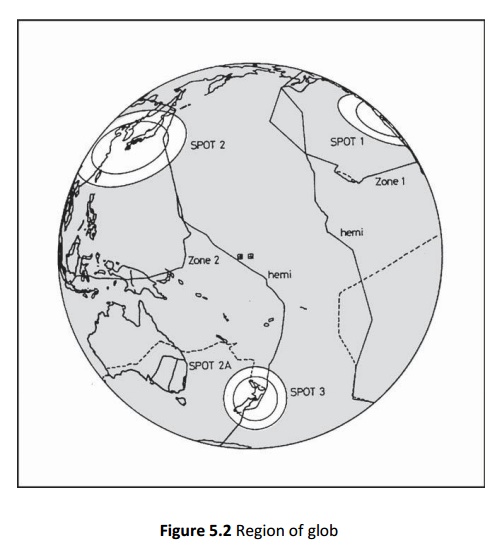Chapter: Satellite Communication : Satellite Applications
INTELSAT Series
INTELSAT Series:
INTELSAT
stands for International
Telecommunications Satellite. The organization was created in 1964 and
currently has over 140 member countries and more than 40 investing entities
(see http://www.intelsat.com/ for more details).
In
July 2001 INTELSAT became a private company and in May 2002 the company began
providing end-to-end solutions through a network of teleports, leased fiber,
and points of presence (PoPs) around the globe.
Starting
with the Early Bird satellite in 1965, a succession of satellites has been
launched at intervals of a few years. Figure 1.1 illustrates the evolution of
some of the INTELSAT satellites. As the figure shows, the capacity, in terms of
number of voice channels, increased dramatically with each succeeding launch,
as well as the design lifetime.
These
satellites are in geostationary orbit, meaning that they appear to be
stationary in relation to the earth. At this point it may be noted that
geostationary satellites orbit in the earth’s equatorial plane and their
position is specified by their longitude.
For
international traffic, INTELSAT covers three main regions—the Atlantic Ocean Region (AOR), the Indian Ocean Region (IOR), and the Pacific Ocean Region (POR) and what is
termed Intelsat America’s Region.
For
the ocean regions the satellites are positioned in geostationary orbit above the
particular ocean, where they provide a transoceanic telecommunications route.
For example, INTELSAT satellite 905 is positioned at 335.5° east
longitude.
The
INTELSAT VII-VII/A series was launched over a period from October 1993 to June
1996. The construction is similar to that for the V and VA/VB series, shown in
Fig. in that the VII series has solar sails rather than a cylindrical body.
The
VII series was planned for service in the POR and also for some of the less
demanding services in the AOR. The antenna beam coverage is appropriate for
that of the POR. Figure 1.3 shows the antenna beam footprints for the C-band
hemispheric cover- age and zone coverage, as well as the spot beam coverage
possible with the Ku-band antennas (Lilly, 1990; Sachdev et al., 1990). When
used in the AOR, the VII series satellite is inverted north for south (Lilly,
1990), minor adjustments then being needed only to optimize the antenna pat-
terns for this region. The lifetime of these satellites ranges from 10 to 15
years depending on the launch vehicle.
Recent
figures from the INTELSAT Web site give the capacity for the INTELSAT VII as
18,000 two-way telephone circuits and three TV channels; up to 90,000 two-way
telephone circuits can be achieved with the use of “digital circuit mul-
tiplication.”
The
INTELSAT VII/A has a capacity of 22,500 two-way telephone circuits and three TV
channels; up to 112,500 two-way tele- phone circuits can be achieved with the
use of digital circuit multipli- cation. As of May 1999, four satellites were
in service over the AOR, one in the IOR, and two in the POR.

The
INTELSAT VIII-VII/A series of satellites was launched over the period February
1997 to June 1998. Satellites in this series have similar capacity as the VII/A
series, and the lifetime is 14 to 17 years.
It
is standard practice to have a spare satellite in orbit on high- reliability
routes (which can carry preemptible traffic) and to have a ground spare in case
of launch failure.
Thus
the cost for large international schemes can be high; for example, series IX,
described later, represents a total investment of approximately $1 billion.

Related Topics